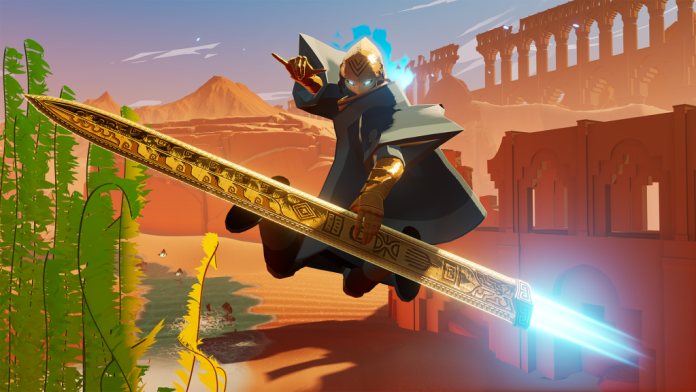Can video games be art? It’s a topic that’s always been up for some debate but now developers Giant Squid are here with Sword of the Sea, and they make a pretty strong argument that games most certainly can be art. With gorgeous visuals, a great gameplay loop and an incredible soundtrack, Sword of the Sea looks to bring a little life back into the world.
Let’s hit the waves in our spoiler free review for Sword of the Sea.
Wraith Against Time
In Sword of the Sea, you play as the stoic and entirely silent ‘Wraith’, who is brought back to life by a single drop of water, that perhaps contains the very power of the sea itself. Head ablaze in ethereal blue flame and broadsword in hand, it seems you have a singular purpose – to bring life back into the world.
I say ‘broadsword in hand’ but that’s not entirely correct. In Sword of the Sea a traditional sword isn’t going to be of much use, as there’s not really any combat to speak of. Instead, your sword acts as some sort of rocket-powered hoverboard, the pommel disappearing when you mount it. This fancy ‘hoversword’ carries our protagonist around on possibly the coolest video game representation of ‘surfing’ I’ve ever seen, let alone played.
I don’t have any particular nostalgia or fond memories of games like Tony Hawk’s Pro Skater or SSX, and my general lack of video game ‘balancing’ on things at speed closely resembles my real life skills – they are non-existent. I would assuredly do myself an injury if I ever stepped on to a real skateboard, snowboard or surfboard to try and pull off some of what you can do in Sword of the Sea, but thankfully Giant Squid make getting around almost zen-like.
You can’t faceplant or take a nasty tumble, and your hoversword will simply fly forward wherever you direct it to go. There’s a wonderful sense of pure unbridled play at work here, the game smartly introducing new concepts as you make your way through the narrative, which is delivered without a single spoken word. There’s no HUD to speak of, and occasional prompts will make themselves apparent to deliver information, and fade away quickly. There are hidden monuments that provide some additional lore about the world you find yourself in, but for the most part, Giant Squid quite expertly let some fantastic visuals and intuitive design guide you, all aptly aided by a wonderful score from Austin Wintory.
Flow State
The lands of Sword of the Sea are ever moving, a mesmerizing constant of shifting dunes, flowing rock and powdery snow. The environment is as rhythmic and undulating as a vast ocean, it just seems to have lost the many forms of life that once existed. Landscapes are frequently breath-taking, from vast, rippling deserts with flowing falls of sand, enormous, snow covered mountains dotted with vast structures and hidden, underground cities, all desperately wanting to be brought back to life.
If you’ve ever played any of Giant Squid’s previous titles like ABZU or The Pathless, there’s a recurring theme of revitalisation, of bringing something back into the world again. That motif persists in Sword of the Sea, and as you explore, you’ll solve various environmental puzzles to bring monumental change to entire regions of the game.
When those transformations occur, they are more often than not utterly breath-taking, a dizzying combination of colour and movement. Huge jellyfish burst forth, providing a convenient ‘Finding Nemo’ style of traversal to access new areas. Schools of fish in all sorts of shapes and sizes appear often flowing towards the next objective to subtly hint to the player on where to go next. Deep green or pink kelp sprout from the sand upon which we can flow upwards for as long as they will let us. As deep blue water appears, utterly transforming these shifting lands before our eyes, you realise – the sea is still here, just waiting to be revealed. There is apparently a photo-mode included, but I couldn’t find it for the life of me. Perhaps it’s an in-game unlock? I’m glad though, because Sword of the Sea deserves one – it’s a beautiful game.
Surf’s Up!
As you transform more and more of the various regions of the world, chapter by chapter, each section opens up to become a bright and colourful skate-park of sorts. The Wraith’s movement when on water is greatly accelerated, allowing for all sorts of cool jumps and tricks. Again, that wonderful sense of play is readily apparent as you are actively encouraged to explore every nook and cranny, making broad and sweeping changes to the very land itself.
It helps of course, that the controls are so well refined. While I played on PC, the game does utilise haptic feedback via PlayStation 5’s Dualsense controller. I didn’t have one to hand, but even on a standard Xbox controller, it all felt fantastic and makes navigating the world a reward in and of itself. There are all sorts of hidden collectibles from hidden frogs to find or hard to reach shells to somehow forge a path towards. With plenty of achievements to earn, exploration is a joy in Sword of the Sea, with the very land itself constantly encouraging you to build momentum, ride on walls and basically look awesome at all times. There are even bespoke ‘skate-parks’ where you can earn a high score for a reward.
As you progress through the narrative, bringing life to different sections of the world and encountering new ones, you’ll collect gold, which you can use to buy new abilities for your Wraith to aid you in your journey. There’s a slight ‘metroidvania’ ‘slant to these, in that on your first playthrough, you’ll not be able to access every area in every region, or at least not be able to realise you can. Frequently, you’ll encounter a trader of sorts who will grant you new abilities for the right amount of currency in return. These start off playful, with the ability to perform tricks like flips or grabs, but later a super jump and even a boost mechanic come along, allowing you to explore further.
Smartly, Giant Squid have included a New Game Plus at launch, which allows you to replay with those abilities unlocked from the get-go once you’ve completed the game. The first playthrough took me around 3-4 hours, but I’ve replayed it once through again and still have more to go find and do. While the entire game has no HUD to speak of, once you’ve completed it the first time you can unlock a speedometer and a Trick meter to track your score. In fact, your “score” is being tracked the entire time, and you’ll be given a total at the end of your first playthrough. Don’t be afraid to pull as many tricks as you can while you’re exploring, it’s part of the fun!
Creation and Conflict
While this review won’t spoil the plot, it’s worth saying that you’re not alone out there in this strange, shifting land. There are other forces at play, for good and for ill. From giant sea creatures to unexpected allies that bring with them entirely new mechanics, it’s all told through a mixture of short cutscenes and wonderful music, and is well paced throughout.
The story telling is backed up by wonderful art direction, and every region felt unique with a renewed sense of discovery as you make your way through. There’s not any really direct conflict, (despite having a sword throughout) aside from one section towards the end, but even that part was in keeping with the game thematically. The puzzles you’ll encounter are relatively simple, and as there’s no real ‘fail’ state, it’s a very frictionless affair – the real challenge comes from exploring and navigating the world, making new discoveries and tracking down hidden items.
Regardless, while I thoroughly enjoyed the narrative and gameplay on offer, if you’ve ever played Giant Squid’s previous work, particularly ABZU, some elements present in Sword of the Sea will feel a little too familiar. I couldn’t shake the feeling I’d experienced many of these moments before, and that feeling persisted through a lot of my time with the game. It’s a minor issue, and of course, your mileage may vary.
Art Imitates Life
Can video games be art? From a pure artistic standpoint, I’d argue one look at Sword of the Sea would make a believer out of most, and as the best art imitates life, Sword of the Sea is full to the brim. The developers have gone beyond here, putting the focus quite rightly on how it feels to play, and that gameplay focus was the right choice to make.
Giant Squid have taken a giant leap forward with Sword of the Sea, fusing gameplay, music and art together to form what I feel is their best work yet. Sword of the Sea might be on the shorter side, but through some sublime ‘hover-swording’ and wonderful design, they’ve given us an imaginative skatepark to play in for as long as we’d like. Bitchin’.
Sword Of The Sea
Played on
PC

PROS
- Gorgeous Visuals
- Tons of Replayability
- Addictive Gameplay Loop
- Sublime Controls
- It’s like, a total vibe man.
CONS
- Story-wise, it feels like ABZU 2.0 – with surfing.
- It is short (if you’re not interested in multiple playthroughs)
Jon “Sikamikanico” Clarke
Stuck on this god-forsaken island. Father of two, wishes he could play more games but real life always gets in the way. Prefers shorter and often smarter experiences, but Halo is King.
Read Next
6 hours ago
Trails in the Sky 1st Chapter | Demo Impressions
2 days ago
inZOI “Island Getaway” DLC | Impressions
3 days ago
Dorfromantik | Review
3 days ago
Echoes of the End | Review
6 days ago

